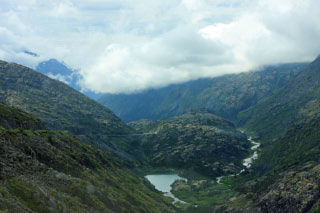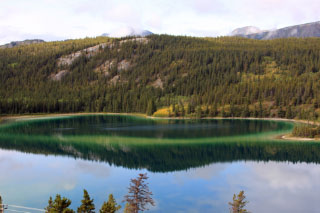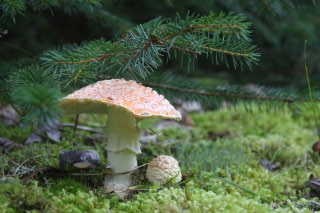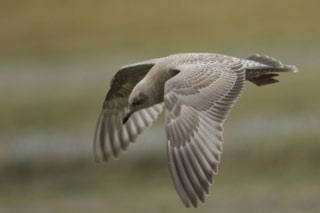 Day
104 - August 27 - Skagway
Day
104 - August 27 - Skagway Chapter 17. Southeastern Alaska
 Day
104 - August 27 - Skagway
Day
104 - August 27 - Skagway (Shari) It is apropos that today we travel on one of the prettiest drives of
the trip. I know I say that almost every day. But this one is special. It is our
42nd wedding anniversary and we are plunging down 11.5 mi. on a 7% grade to one
of my favorite towns, Skagway. The drive does not disappoint, in fact it is
prettier than I remember. The yellows of the aspen intertwined with the pine and
spruce add color to the already spectacular scene. The road follows a gorge and
we are surrounded by mountains. It is the same gorge that the gold rush
stampedeers saw when climbing it with their 1500 pounds of stuff. Down, down,
down we go with our air brake holding us back from plummeting over the edge
until we reach the RV park. After arriving, I get potatoes ready for our
potluck. We gather around our rig (no rain) and enjoy the baked potatoes with
toppings like chili, creamed ham, broccoli, cheese, butter and sour cream. Even
our sweet tooth gets satisfied since I have made a dessert for August birthdays
and anniversaries and Betty brought ice cream.

(Bert) A route of dramatic scenery of great variety, we travel only a short distance of 105 mi., yet cross from Yukon Territory to British Columbia to the U.S., descending to the Pacific Ocean at Lynn Canal in Skagway. Along the way we stop, as always, at Emerald Lake, an oddity of blue, green and pale yellow colors created by sunlight reflecting off a marl lake bed of white calcium carbonate, the work of diatoms. A new interpretative display illustrates the effects of global warming on the Yukon, where warming has occurred more quickly than other areas. The invasion of spruce bark beetles has devastated forests previously untroubled by the insect that cannot survive in colder climes. Caribou are threatened by the shrinking of glacial ice patches which they use for escaping insects and heat. This year’s trip has been an eye opener to the perils of global warming, something I have noticed for over a decade and only see now as impending doom. Compounded with an oil crisis, short-sighted planning and naïve politicians everywhere, I really wonder what type of world my grandchildren will see in their maturity.
(Bert) I’ve wondered why Dyea is pronounced “die ee” and what it means. From
national park service guide Emma I learn part of the explanation. Dyea is a
Tlingit word for “to pack”. The First Nations band of Tlingits did not settle in
Dyea, only using it as a packing camp for transporting fish. It was the gold
stampeders that made it famous for a brief point in history during the end of
the 19th century. Now it
 is
a ghost town with hardly a trace of the 100+ buildings and businesses, the mile
long wharf, or the thousands of stampeders that climbed the Chilkoot Trail to
reach the Klondike gold fields at Dawson City. Emma gives us an excellent tour
and history of Dyea, interrupted twice when we pause for overhead birds:
Golden-crowned Kinglets, Vaux Swifts, Chestnut-backed Chickadees and Townsend’s
Warblers. Overall, birds are scarce and considerably fewer than my other visits
to the Skagway area. But, then again, this is the latest in the season of any
prior visits and it seems many of the migrants are now south of Alaska. Making
up for a lack of birds is a bounty of mushrooms. I’ve never seen so many and
such great variety. I photograph many because of their diversity of shapes and
colors, although I probably can identify only a very few.
is
a ghost town with hardly a trace of the 100+ buildings and businesses, the mile
long wharf, or the thousands of stampeders that climbed the Chilkoot Trail to
reach the Klondike gold fields at Dawson City. Emma gives us an excellent tour
and history of Dyea, interrupted twice when we pause for overhead birds:
Golden-crowned Kinglets, Vaux Swifts, Chestnut-backed Chickadees and Townsend’s
Warblers. Overall, birds are scarce and considerably fewer than my other visits
to the Skagway area. But, then again, this is the latest in the season of any
prior visits and it seems many of the migrants are now south of Alaska. Making
up for a lack of birds is a bounty of mushrooms. I’ve never seen so many and
such great variety. I photograph many because of their diversity of shapes and
colors, although I probably can identify only a very few.
 After
the tour we head out on the wetlands toward Lynn Canal, finding American Pipits,
Northwestern Crows, Pectoral Sandpipers
After
the tour we head out on the wetlands toward Lynn Canal, finding American Pipits,
Northwestern Crows, Pectoral Sandpipers,
and a first-year Herring Gull. In the wooded areas we search for woodpeckers,
finding none, but a profusion of ripening berries that only later do we confirm
as High Bush Cranberries. Then we head to the start of the Chilkoot Trail. We
have been hearing about the gold rush now for many weeks, seen countless
exhibits and visited the gold fields still in operation. Now we get to hike the
trail and get a taste of how difficult it must have been for the stampeders to
transport their near ton of goods up the trail to the pass and beyond to Dawson
City. One surprise along the trail is a fresh pile of bear scat loaded with
undigested cranberries
adjacent to two Sitka Spruce, scraped clean of bark by bear scratching. Our hike
is only 0.6 mi. one-way, with an elevation gain of 278 ft. according to Steve’s
GPS, before we decide we have had enough of a taste. The steep part is still far
beyond our turning point.
(Shari) I wish I could stay in Skagway another week. Today turns out to be so pretty and only one cruise ship is in town. After our morning chores, Bert and I walk the reconstructed gold rush town. Sponsored by the National Park Service, we join a free tour of some of the old and restored buildings. We share an ice cream cone, look and find two caches and go to a restaurant that is new to us. It has the most spectacular gardens associated with it. Growing amongst the vegetables used inside the restaurant are flowers and more flowers. The landscaping includes an outdoor miniature train traveling around town settings, rocks, hills and miniature trees. We find Bill and Ginny and Chris and Curt also walking the gardens. They graciously ask us to join them and for the next two hours we have a delightful time at the dinner table. Not a cheap meal when you add the bottle of wine and the dinner salad, but the food is delicious and the company superb. All six of us have anniversaries within two weeks of today so we justify the cost as an anniversary treat. Then Bert reminds me that he already got me a gift. He gave me an ivory carved beluga whale that he bought from the carver in Gambell. Oh well, it is only money.
(Bert) Skagway is pleasantly quieter this afternoon, as only one cruise ship is in the dock. Yesterday, John told me there were six ships and 10,000 people. Shari and I join the walking tour led by the National Park Service worker and learn some details about Skagway history we hadn’t heard on previous visits. Our guide wove his tour together with a succession of stories, including one about Captain William Moore who had the foresight to recognize a gold rush was coming years before it actually happened. He bought up the land in Skagway, built a sawmill, a wharf and the White Pass trail in anticipation of future profits when the stampeders arrived. And they did arrive a decade later and he became rich from the services he sold to them. Our tour ends at the original cabin he built in the 1800’s and the larger house now restored to the way it appeared in 1904. In the evening we join Bill and Ginny, Curt and Chris, for an excellent dinner at Jewell Gardens and Glassworks, a gourmet restaurant that wasn’t here on our last visit.